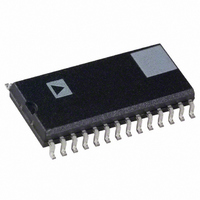AD73322AR Analog Devices Inc, AD73322AR Datasheet - Page 29

AD73322AR
Manufacturer Part Number
AD73322AR
Description
IC ANALOG FRONT END DUAL 28-SOIC
Manufacturer
Analog Devices Inc
Datasheet
1.AD73322LARUZ-REEL.pdf
(43 pages)
Specifications of AD73322AR
Rohs Status
RoHS non-compliant
Number Of Bits
16
Number Of Channels
4
Power (watts)
73mW
Voltage - Supply, Analog
2.7 V ~ 5.5 V
Voltage - Supply, Digital
2.7 V ~ 5.5 V
Package / Case
28-SOIC (7.5mm Width)
Single Supply Voltage (min)
2.7V
Single Supply Voltage (max)
3.3V
Package Type
SOIC W
Lead Free Status / RoHS Status
Not Compliant
Available stocks
Company
Part Number
Manufacturer
Quantity
Price
Part Number:
AD73322AR-REEL
Manufacturer:
ADI/亚德诺
Quantity:
20 000
Company:
Part Number:
AD73322ARZ
Manufacturer:
2002+
Quantity:
6 219
Part Number:
AD73322ARZ
Manufacturer:
ADI/亚德诺
Quantity:
20 000
As the AD73322 can be operated at 8 kHz (see Figure 26) or
16 kHz sampling rates, which make it particularly suited for
voiceband processing, it is important to understand the action of
the interpolator’s Sinc3 response. As was the case with the en-
coder section, if the output signal’s frequency response is not
bounded by the Nyquist frequency it may be necessary to perform
some initial digital filtering to eliminate signal energy above
Nyquist to ensure that it is not imaged at the integer multiples
of the sampling frequency. If the user chooses to bypass the
interpolator, perhaps to reduce group delay, images of the origi-
nal signal will be generated at integer intervals of the sampling
frequency. In this case these images must be removed by exter-
nal analog filtering.
Figure 27 shows the output spectrum of a 1 kHz tone being
generated at an 8 kHz sampling rate with the interpolator
bypassed.
REV. B
Figure 27. FFT (DAC 8 kHz Sampling—Interpolator
Bypassed)
–100
–100
–10
–20
–30
–40
–50
–60
–70
–80
–90
–10
–20
–30
–40
–50
–60
–70
–80
–90
0
0
0
0
Figure 26. FFT (DAC 8 kHz Sampling)
500
0.5
1000
1.0
1500
FREQUENCY – Hz
FREQUENCY – Hz
1.5
2000
2.0
2500
2.5
3000
3500
3.0
4000
10
3.5
4
–29–
Decoder Group Delay
The interpolator roll-off is mainly due to its sinc-cubed function
characteristic, which has an inherent group delay given by the
equation:
where:
The analog section has a group delay of approximately 25 s.
On-Chip Filtering
The primary function of the system filtering’s sinc-cubed (Sinc3)
response is to eliminate aliases or images of the ADCs or DAC’s
resampling, respectively. Both modulators are sampled at a
nominal rate of DMCLK/8 (which is 2.048 MHz for a DMCLK
of 16.384 MHz) and the simple, external RC antialias filter is
sufficient to provide the required stopband rejection above the
Nyquist frequency for this sample rate. In the case of the ADC
section, the decimating filter is required to both decrease sample
rate and increase sample resolution. The process of changing
sample rate (resampling) leads to aliases of the original sampled
waveform appearing at integer multiples of the new sample rate.
These aliases would get mapped into the required signal pass-
band without the application of some further antialias filtering.
In the AD73322, the sinc-cubed response of the decimating
filter creates spectral nulls at integer multiples of the new sample
rate. These nulls coincide with the aliases of the original wave-
form which were created by the down-sampling process, there-
fore reducing or eliminating the aliasing due to sample rate
reduction.
In the DAC section, increasing the sampling rate by interpola-
tion creates images of the original waveform at intervals of the
original sampling frequency. These images may be sufficiently
rejected by external circuitry but the sinc-cubed filter in the
interpolator again nulls the output spectrum at integer intervals
of the original sampling rate which corresponds with the images
due to the interpolation process.
The spectral response of a sinc-cubed filter shows the character-
istic nulls at integer intervals of the sampling frequency. Its
passband characteristic (up to Nyquist frequency) features a
roll-off that continues up to the sampling frequency, where the
first null occurs. In many applications this smooth response will
not give sufficient attenuation of frequencies outside the band of
interest therefore it may be necessary to implement a final filter
in the DSP which will equalize the passband rolloff and provide
a sharper transition band and greater stopband attenuation.
Order is the interpolator order (= 3),
L is the interpolation factor (= 32 @ 64 kHz, = 64 @ 32 kHz,
= 128 @ 16 kHz, = 256 @ 8 kHz) and
T
INT
=> Group Delay (Interpolator @ 64 kHz)
= 3
= 22.7 s
Group Delay (Interpolator) = Order
is the interpolation sample interval (= 1/2.048e6)
(32 – 1)/2
(1/2.048e6)
(L – 1)/2)
AD73322
T
INT













